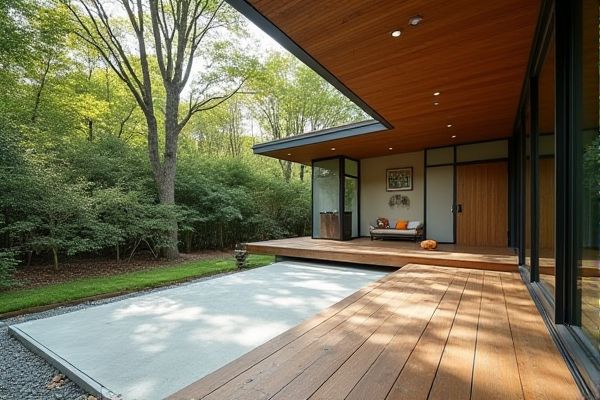
Concrete slabs offer durability, low maintenance, and weather resistance, making them ideal for long-lasting outdoor terraces, while wooden flooring provides a warm, natural aesthetic and comfortable feel underfoot but requires regular upkeep to prevent damage. Explore the rest of the article to determine which flooring option best suits your outdoor living space needs.
Table of Comparison
| Feature | Concrete Slab Flooring | Wooden Terrace Flooring |
|---|---|---|
| Material | Reinforced concrete | Natural or engineered wood |
| Durability | High, resistant to weather and wear | Moderate, susceptible to rot and insects without treatment |
| Maintenance | Low, occasional cleaning and sealing | High, requires regular sealing and staining |
| Installation | Requires skilled labor, longer curing time | Quicker installation, DIY friendly |
| Cost | Moderate to high initial cost | Moderate, varies by wood type |
| Appearance | Modern, sleek, customizable with finishes | Warm, natural aesthetic |
| Comfort | Hard, retains heat | Warmer, more comfortable underfoot |
| Environmental Impact | Higher carbon footprint due to cement production | Renewable resource, sustainable if sourced responsibly |
| Weather Resistance | Excellent resistance to moisture and elements | Needs treatment to withstand moisture and UV rays |
Introduction to Terrace Flooring Options
Concrete slabs offer durability, low maintenance, and excellent resistance to weather, making them a practical choice for terrace flooring in both residential and commercial settings. Wooden terrace flooring provides natural aesthetics, warmth, and a comfortable surface underfoot but requires regular sealing and maintenance to prevent damage from moisture and UV exposure. Choosing between concrete and wood depends on factors like budget, climate, desired appearance, and long-term upkeep preferences.
Overview: Concrete Slab vs Wooden Terrace
Concrete slab terrace flooring offers durability, low maintenance, and resistance to weather elements, making it ideal for long-lasting outdoor spaces. Wooden terrace flooring provides a natural, warm aesthetic with excellent insulation but requires regular upkeep to prevent rot and insect damage. Both materials vary in cost, lifespan, and environmental impact, influencing their suitability based on climate and design preferences.
Durability and Longevity Comparison
Concrete slab flooring offers superior durability and longevity compared to wooden terrace flooring, as it resists weathering, rot, and insect damage while maintaining structural integrity for decades. Wood terraces, though aesthetically pleasing, require regular maintenance such as sealing and staining to prevent warping, cracking, and decay caused by moisture and UV exposure. Consequently, concrete slabs provide a low-maintenance, long-lasting option ideal for outdoor environments with high durability demands.
Installation Process and Complexity
Concrete slab installation involves site excavation, formwork setup, reinforcement placement, and precise pouring followed by curing, requiring skilled labor and specialized equipment, with a longer timeline due to drying times. Wooden terrace flooring installation demands accurate measurement, substructure framing, secure decking board attachment using nails or screws, and potential treatment for weather resistance, generally faster but necessitating routine maintenance. Both methods vary in complexity; concrete offers durability but higher upfront effort, while wood emphasizes ease of installation with ongoing upkeep considerations.
Cost Analysis: Upfront and Long-Term
Concrete slab flooring offers lower upfront costs and exceptional durability, reducing long-term maintenance expenses compared to wooden terraces. Wooden terrace flooring requires higher initial investment due to material and installation but may incur ongoing costs for sealing, staining, and repairs to prevent weather damage. You can achieve cost efficiency by evaluating your budget against expected maintenance needs and lifespan for each option.
Maintenance Requirements and Lifespan
Concrete slabs require minimal maintenance, typically needing only occasional cleaning and sealing every few years to prevent cracks and surface damage. Wooden terrace flooring demands regular upkeep, including sanding, staining, and sealing annually to protect against moisture, rot, and insect damage. While concrete slabs can last over 50 years with proper care, wooden terraces generally have a lifespan of 15 to 25 years depending on the wood type and maintenance consistency.
Aesthetic Appeal and Customization
Concrete slabs offer a sleek, modern aesthetic with versatile finishes such as stamped patterns, stains, and polished surfaces that can mimic natural stone or intricate designs. Wooden terrace flooring provides warm, natural beauty and can be customized with various wood species, stains, and finishes to suit traditional or rustic styles. Your choice depends on whether you prefer the contemporary, low-maintenance look of concrete or the organic, customizable charm of wood.
Climate and Environmental Suitability
Concrete slabs offer superior durability and thermal mass, making them ideal for hot climates as they absorb and slowly release heat, reducing indoor temperature fluctuations. Wooden terrace flooring provides better insulation and a warmer aesthetic, suitable for cooler or temperate climates where maintaining warmth is essential. Environmentally, sustainably sourced wood is renewable and has a lower carbon footprint compared to concrete, which relies heavily on energy-intensive cement production.
Safety, Comfort, and Practical Usage
Concrete slab flooring offers superior safety due to its slip-resistant surface and structural stability, reducing the risk of accidents in outdoor terraces. Wooden terrace flooring provides enhanced comfort with natural insulation properties and a warmer feel underfoot, making it ideal for extended outdoor use. Practical usage varies as concrete requires minimal maintenance and withstands harsh weather, while wood demands regular sealing and care but allows for easier customization and repair.
Sustainability and Eco-Friendly Choices
Concrete slabs offer durability and low maintenance but have a higher carbon footprint due to cement production, impacting sustainability. Wooden terrace flooring, especially when sourced from certified sustainable forests or using reclaimed wood, provides a renewable and biodegradable option that enhances eco-friendliness. Choosing your terrace material with environmental impact in mind supports greener living and promotes sustainable construction practices.
 homyna.com
homyna.com